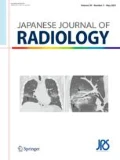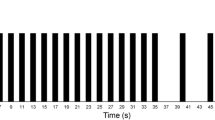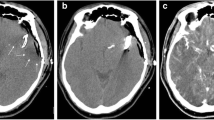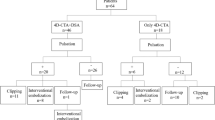Abstract
Purpose
To determine whether sufficient pre-surgical treatment information of unruptured intracranial aneurysms can be obtained by using 320-row detector CT angiography (CTA) alone.
Materials and methods
We enrolled 40 consecutive patients with unruptured intracranial aneurysms. All patients were prospectively conducted to perform 320-detector CTA as the only preoperative modality. Two blinded readers independently assessed CTA images. Interobserver agreement and the agreement between CTA and surgical findings were determined by calculating the κ coefficient. The referring neurosurgeons judged the usefulness of the information provided by CTA for treatment decisions.
Results
All patients had surgery without intraarterial digital subtraction angiography. Agreement between CTA and surgical findings was excellent for the aneurysm location (κ = 1.0) and good for the shape (κ = 0.71), neck (κ = 0.74) and its relationship with adjacent branches (κ = 0.71). Information obtained with 320-detector CTA was highly useful for surgical treatment in 37 of 40 (93 %) patients, although small perforators deriving from the aneurysm in 2 cases were not fully visualized on CTA images.
Conclusion
In most patients with unruptured intracranial aneurysms, sufficient pre-surgical treatment information can be obtained by using 320-detector CTA alone.



Similar content being viewed by others
References
Cloft HJ, Joseph GJ, Dion JE. Risk of cerebral angiography in patients with subarachnoid hemorrhage, cerebral aneurysms, and arteriovenous malformations: a meta-analysis. Stroke. 1999;30:317–20.
Papke K, Kuhl CK, Fruth M, et al. Intracranial aneurysms: role of multidetector CT angiography in diagnosis and endovascular therapy planning. Radiology. 2007;244:532–40.
Li Q, Lv F, Li Y, Luo T, Li K, Xie P. Evaluation of 64-section CT angiography for detection and treatment planning of intracranial aneurysms by using DSA and surgical findings. Radiology. 2009;252:808–15.
Westerlaan HE, van Dijk JM, Jansen-van der Weide MC, et al. Intracranial aneurysms in patients with subarachnoid hemorrhage: CT angiography as a primary examination tool for diagnosis—systematic review and meta-analysis. Radiology. 2011;258:134–45.
Anderson GB, Steinke DE, Petruk KC, Ashforth R, Findlay JM. Computed tomographic angiography versus digital subtraction angiography for the diagnosis and early treatment of ruptured intracranial aneurysms. Neurosurgery. 1999;45:1315–20.
Hoh BL, Cheung AC, Rabinov JD, Pryor JC, Carter BS, Ogilvy CS. Results of a prospective protocol of computed tomographic angiography in place of catheter angiography as the only diagnostic and pretreatment planning study for cerebral aneurysms by a combined neurovascular team. Neurosurgery. 2004;54:1329–40.
Moran CJ. Aneurysmal subarachnoid hemorrhage: DSA versus CT angiography—is the answer available? Radiology. 2011;258:15–7.
Hayakawa M, Maeda S, Sadato A, et al. Detection of pulsation in ruptured and unruptured cerebral aneurysms by electrocardiographically gated 3-dimensional computed tomographic angiography with a 320-row area detector computed tomography and evaluation of its clinical usefulness. Neurosurgery. 2011;69:843–51.
Luo Z, Wang D, Sun X, et al. Comparison of the accuracy of subtraction CT angiography performed on 320-detector row volume CT with conventional CT angiography for diagnosis of intracranial aneurysms. Eur J Radiol. 2012;81:118–22.
Sun G, Ding J, Lu Y, et al. Comparison of standard- and low-tube voltage 320-detector row volume CT angiography in detection of intracranial aneurysms with digital subtraction angiography as gold standard. Acad Radiol. 2012;19:281–8.
Nahed BV, DiLuna ML, Morgan T, et al. Hypertension, age and location predict rupture of small intracranial aneurysms. Neurosurgery. 2005;57:676–83.
Yamashiro S, Nishi T, Koga K, et al. Postoperative quality of life of patients treated for asymptomatic unruptured intracranial aneurysms. J Neurosurg. 2007;107:1086–91.
Sonobe M, Yamazaki T, Yonekura M, Kikuchi H. Small unruptured intracranial aneurysm verification study: SUAVe study, Japan. Stroke. 2010;41:1969–77.
Matsuki M, Tanikake M, Kani H, et al. Dual-phase 3D CT angiography during a single breath-hold using 16-MDCT: assessment of vascular anatomy before laparoscopic gastrectomy. AJR Am J Roentgenol. 2006;186:1079–85.
Bae KT. Intravenous contrast medium administration and scan timing at CT: considerations and approaches. Radiology. 2010;256:32–61.
Barrett JF, Keat N. Artifacts in CT: recognition and avoidance. Radiographics. 2004;24:1679–91.
Nagahata M, Abe Y, Ono S, et al. Attenuation values of the intracranial arterial and venous vessels by bolus injection of various contrast agents: a study with a single-detector helical CT scanner. Radiat Med. 2007;25:89–93.
Tamura Y, Utsunomiya D, Sakamoto T, et al. Reduction of contrast material volume in 3D angiography of the brain using MDCT. AJR Am J Roentgenol. 2010;195:455–8.
Kim JK, Farb RI, Wright GA. Test bolus examination in the carotid artery at dynamic gadolinium-enhanced MR angiography. Radiology. 1998;206:283–9.
Nakaura T, Awai K, Maruyama N, et al. Abdominal dynamic CT in patients with renal dysfunction: contrast agent dose reduction with low tube voltage and high tube current-time product settings at 256-detector row CT. Radiology. 2011;261:467–76.
Khan A, Khosa F, Nasir K, Yassin A, Clouse ME. Comparison of radiation dose and image quality: 320-MDCT versus 64-MDCT coronary angiography. AJR Am J Roentgenol. 2011;197:163–8.
Kobayashi M, Koshida K, Suzuki S, Katada K. Evaluation of geometric efficiency and radiation exposure in z-axis for volume scan. Radiat Prot Dosimet. 2011;143:63–8.
Mnyusiwalla A, Aviv RI, Symons SP. Radiation dose from multidetector row CT imaging for acute stroke. Neuroradiology. 2009;51:635–40.
Conflict of interest
The authors declare that they have no conflict of interest.
Author information
Authors and Affiliations
Corresponding author
About this article
Cite this article
Hayashida, E., Sasao, A., Hirai, T. et al. Can sufficient preoperative information of intracranial aneurysms be obtained by using 320-row detector CT angiography alone?. Jpn J Radiol 31, 600–607 (2013). https://doi.org/10.1007/s11604-013-0228-2
Received:
Accepted:
Published:
Issue Date:
DOI: https://doi.org/10.1007/s11604-013-0228-2




